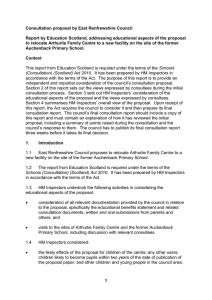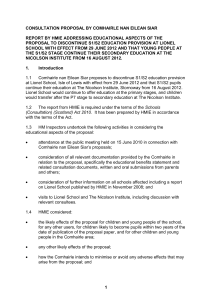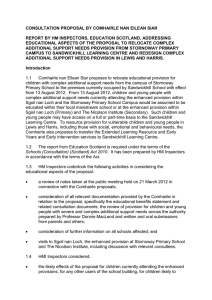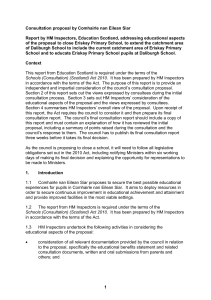Report by Education Scotland addressing educational aspects of the proposal by
advertisement
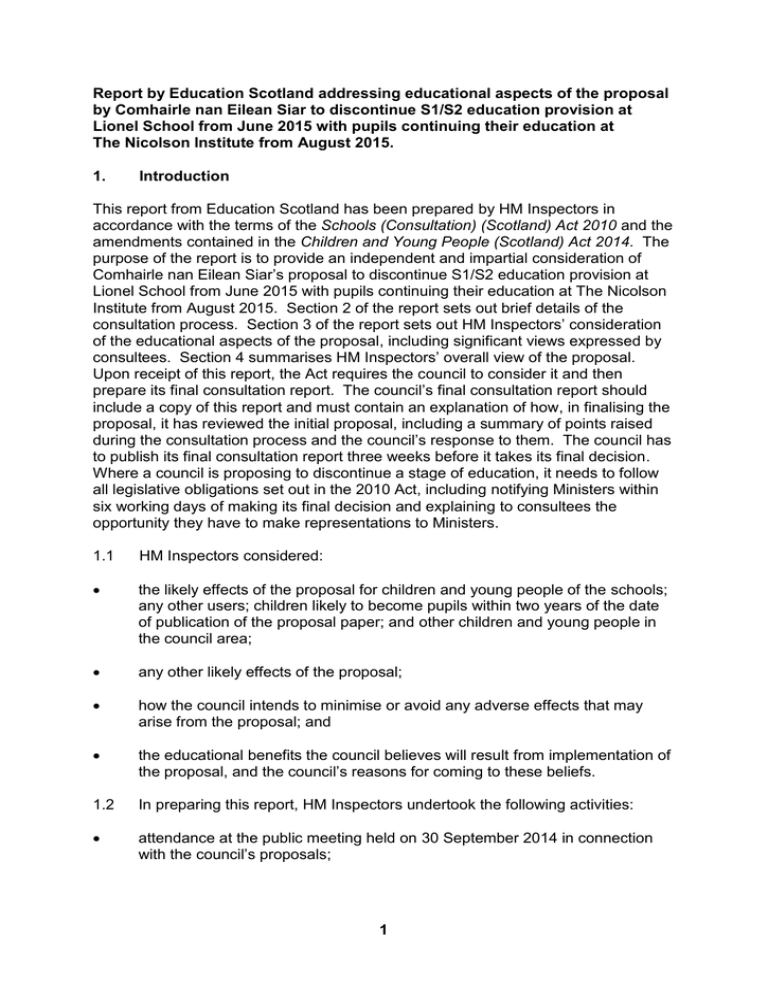
Report by Education Scotland addressing educational aspects of the proposal by Comhairle nan Eilean Siar to discontinue S1/S2 education provision at Lionel School from June 2015 with pupils continuing their education at The Nicolson Institute from August 2015. 1. Introduction This report from Education Scotland has been prepared by HM Inspectors in accordance with the terms of the Schools (Consultation) (Scotland) Act 2010 and the amendments contained in the Children and Young People (Scotland) Act 2014. The purpose of the report is to provide an independent and impartial consideration of Comhairle nan Eilean Siar’s proposal to discontinue S1/S2 education provision at Lionel School from June 2015 with pupils continuing their education at The Nicolson Institute from August 2015. Section 2 of the report sets out brief details of the consultation process. Section 3 of the report sets out HM Inspectors’ consideration of the educational aspects of the proposal, including significant views expressed by consultees. Section 4 summarises HM Inspectors’ overall view of the proposal. Upon receipt of this report, the Act requires the council to consider it and then prepare its final consultation report. The council’s final consultation report should include a copy of this report and must contain an explanation of how, in finalising the proposal, it has reviewed the initial proposal, including a summary of points raised during the consultation process and the council’s response to them. The council has to publish its final consultation report three weeks before it takes its final decision. Where a council is proposing to discontinue a stage of education, it needs to follow all legislative obligations set out in the 2010 Act, including notifying Ministers within six working days of making its final decision and explaining to consultees the opportunity they have to make representations to Ministers. 1.1 HM Inspectors considered: the likely effects of the proposal for children and young people of the schools; any other users; children likely to become pupils within two years of the date of publication of the proposal paper; and other children and young people in the council area; any other likely effects of the proposal; how the council intends to minimise or avoid any adverse effects that may arise from the proposal; and the educational benefits the council believes will result from implementation of the proposal, and the council’s reasons for coming to these beliefs. 1.2 In preparing this report, HM Inspectors undertook the following activities: attendance at the public meeting held on 30 September 2014 in connection with the council’s proposals; 1 consideration of all relevant documentation provided by the council in relation to the proposal, specifically the educational benefits statement and related consultation documents, written and oral submissions from parents and others; and visits to the site of Lionel School and The Nicolson Institute, including discussion with relevant consultees. 1.3 As the proposal will lead to the closure of a stage of education in a rural school, HM Inspectors also took into account the council’s consideration of any reasonable alternatives to the closure of S1/S2 education at Lionel School, the likely effect on the local community and the likely effect of any different travel arrangements of the proposed closure. 2. Consultation Process 2.1 Comhairle nan Eilean Siar undertook the consultation on its proposal with reference to the Schools (Consultation) (Scotland) Act 2010 and the amendments in the Children and Young People (Scotland) Act 2014. The consultation period ran from 11 September 2014 until 7 November 2014. Advertisements were placed in local newspapers. A public meeting was held on Tuesday 30 September 2014. Approximately 300 written responses were made to the consultation, from parents, pupils and members of the local community. Of these, almost all were opposed to the proposal. In addition to the large number of respondents, Lionel School Parent Council submitted written evidence to the council. Two petitions, both opposed to the proposal, were also submitted to the council. Under the terms of the Schools (Consultation) (Scotland) Act 2010, Bòrd na Gàidhlig is listed by the council as a consultee on the proposals. The council did not receive a response from Bòrd na Gàidhlig during the period of consultation. 3. Educational Aspects of Proposal 3.1 Lionel School provides education from nursery to S2 and serves the community of Port Nis and surrounding areas on the far north coast of Lewis. Currently, pupils automatically transfer to The Nicolson Institute in Stornoway at the end of S2. The school is situated 27 miles from The Nicolson Institute. The journey time takes between 40 and 60 minutes by bus. Comhairle nan Eilean Siar made a decision in November 2010 to discontinue S1/S2 education at Lionel School from 29 June 2012. This decision was called in by Scottish Ministers, and Comhairle nan Eilean Siar subsequently reconsidered its position and agreed on 21 June 2012 not to discontinue the provision. However, since 2012, the roll of the school has significantly declined. The current combined roll in S1/S2 is eight children. This is due to most parents choosing to send their children directly from P7 to The Nicolson Institute. Projected rolls for future years are larger but these figures do not take account of any future placing requests made by parents to The Nicolson Institute. 3.2 The council has set out in detail a number of important educational benefits for children who would transfer to The Nicolson Institute at the end of P7 should the proposal go ahead. These include young people’s access to a more appropriate curriculum; a larger peer group; enhanced leadership and management capacity; a 2 more suitable learning environment and resources, and enhanced provision for those who require additional support with their learning. Young people who are fluent in Gaelic would also benefit from access to learning in the medium of Gaelic in a wider range of subjects at The Nicolson Institute. The council has also set out clearly how implementation of the proposal will enable it to secure best value in the delivery of its services. Taken together, these form a strong case for the overall educational benefits of the proposal. 3.3 The council outlines clearly how the proposal will improve the quality of the curriculum. Should the proposal go ahead, young people will access a greater number of subject specialist teachers and access a curriulum that allows for greater choice, depth and continuity of learning. Young people would have access to a wider choice of out of school activities at The Nicolson Institute. They would have greater access to initiatives such as supported study classes, as well as more opportunities to be involved in team sports. Currently at Lionel School all eight S1 and S2 children learn together in a multi-stage class. Parents and a number of young people who met with HM Inspectors expressed the view that the potential benefits of this current arrangement would be lost, including small class sizes. However, should the proposal go ahead young people will have greater opportunities to work with a larger peer group which would bring benefits of better social and learning opportunities. In addition, most staff felt the arrangements for leading and managing one site would allow for a more efficient use of staff time and resources. Overall, most staff in both schools felt that the proposal offered significant educational benefits although a few were in favour of retaining the current arrangements. 3.4 The Nicolson Institute provides a modern, purpose-built environment for learning. This includes break-out areas for particular groups to work and socialise, modern information and communication technology and sporting facilities, language laboratories and multi-media rooms. Facilities to encourage performing skills, including music and drama, are of a high quality. The school has purpose-built specialised areas and resources which cater well for children with a wide range of needs, including those with complex medical needs. In addition, the school benefits from 5.5 full-time equivalent specialist support for learning teachers. 3.5 A number of parents and large numbers from the community strongly oppose the proposal. However, parents who expressed views at the public meeting, in writing and in discussion with HM Inspectors, were almost exclusively parents of children who currently attend Lionel School or have done so in the past. Very few parents who had chosen to exercise their right to make placing requests for their children at The Nicolson Institute made representations to the council either in support of, or in opposition to, the proposal. Most who were opposed to the proposal had concerns about a range of common issues, including the impact on young people of the proposed bus journey to and from school. The council has outlined how it will minimise journey times, such as providing extra buses and the establishment of traffic lights to ease congestion. These arrangements have already been put into place and the impact of them has had a small, but positive effect on total journey times. In addition, some parents who were opposed to the proposal were concerned about issues about safety and supervision on the school bus and the safety of travelling in winter weather. Should the proposal go ahead, the council 3 should continue to take steps to reassure parents about procedures for ensuring safe travel to and from school. A number of parents also expressed concern around current lunch arrangements at The Nicolson Institute. The council has taken positive steps to address this issue. These include a staggered lunch rota arrangement, further canteen facilities and plans to build an enclosed shelter for pupils accessing the ‘grab and go’ lunch facility. 3.6 Children and young people’s views on the proposal were mixed. A number of those who were opposed to the proposal had put their views in writing to the council. Those currently in S1 and S2 at Lionel School, who met with HM Inspectors, reported that they were happy and settled in their class and gave strong support to retaining the current arrangements. Those in the primary classes at Lionel School were opposed to the proposal and wanted to have the option of remaining at Lionel School for the first two years of secondary education. Those at The Nicolson Institute who had attended Lionel School in the past spoke positively about their experiences at Lionel School. In the main, they felt that they had been well prepared for life at a large secondary following their S1/S2 experience at Lionel School. However, a few felt that they had been disadvantaged by the late start at The Nicolson Institute. Those who had opted to go straight to The Nicolson Institute from P7 felt this had been the right choice. All young people who met with HM Inspectors and currently attend The Nicolson Institute, spoke very positively about their experiences, achievements and support they received. 3.7 The council received several hundred signed objections from members of the local communities, both in the form of individual responses and a standard signed objection letter. These letters detailed various concerns about the impact of the proposed discontinuation of education in S1/S2 at Lionel School on the community. Members of the community stated that they were concerned about the longer term economic impact on the local and surrounding communities. They did not feel that the council had taken a long-term or detailed enough view of the impact of the proposed closure. They believed that it would discourage families from moving to the area, influencing longer term community growth. There were also concerns expressed about the effect long journeys would have on family values, the continuation of the Gaelic language and culture which is prominent in the community and the family ethos, including involvement of local churches. 3.8 During the consultation period parents and consultees identified a number of alleged inaccuracies or omissions in the proposal. These included issues around projected future rolls and a perceived lack of clarity about projected financial savings and how well the council had costed and considered the viability of alternative arrangements. The council will need to ensure that it takes the necessary steps to investigate these and, in its final consultation report, should set out the actions it has taken to address these issues. 3.9 As the proposal will lead to the closure of a rural school, HM Inspectors also took account of the council’s consideration of the factors to which it should have special regard. In its proposal paper, the council has identified five alternatives to the proposal. It has assessed the viability of each of these and has set out the reasons why the council considers discontinuation of S1/S2 provision at Lionel School as the most viable course of action open to it. As the council is proposing to 4 discontinue S1/S2 provision at Lionel School, the council has given reasonable consideration to the impact of the proposal on the local community. If the council implements the proposal, the primary school and all of the building’s facilities will still be available to members of the public and the local community. The council has given due consideration to the differing travel arrangements that will arise from implementation of the proposal. It recognises that travel times to the secondary school may influence choice of location for some families. It does not consider this to be a significant enough factor to prevent implementation of the proposal. However, stakeholders who responded to the proposal and who met with HM Inspectors did not feel the council had consulted them effectively on the viability of alternatives to discontinuing provision in S1/S2 at Lionel School. They also challenged the council’s assessment of the impact of the proposal on the local community and the differing travel arrangements. They strongly contested these elements of the council’s proposal. In its final consultation report, the council needs to consider the points raised by stakeholders. 4. Summary 4.1 Comhairle nan Eilean Siar has set out a clear case for the overall educational benefit of the proposal. If the proposal is implemented, young people moving to The Nicolson Institute would benefit from an improved curriculum, a larger peer group and access to high-quality resources, including for those who require additional support with their learning. In addition, children will benefit from an improved physical learning environment. The proposal will also help the council meet its duty to secure best value in the delivery of its services, including the more efficient deployment of specialist teachers and senior managers. The council has taken positive steps to address concerns around safe travel to school. 4.2 A number of parents, children and young people and other stakeholders are strongly opposed to the proposal and have a range of concerns about it. These are set out in this report. In reviewing the proposal and preparing its final consultation report, the council needs to work closely with parents, staff, children and the wider community in addressing their concerns. This includes their remaining concerns about safety and supervision arrangements on school transport. The council also needs to address the alleged errors and omissions in the proposal. These include those highlighted by the Parent Council at Lionel School in its written submission to the council. HM Inspectors Education Scotland November 2014 5




